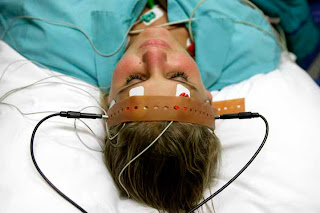Minimize Cognitive Side Effects with ECT

Optimizing the technique of ECT can minimize cognitive side effects. These optimizing measures for ECT technique are:
- Use brief pulse stimulus (0.5 to 2 milliseconds)instead of sine wave stimulus. This has a positive effect on cognitive side effects. It is not yet clear if ultrabrief pulse waveform (pulse width of less than 0.5 milliseconds) will produce even fewer cognitive side effects without sacrificing efficacy.
- Right Unilateral Electrode placement when performed right has the best benefit/risk ratio concerning cognitive side effects. Performed right means using brief pulse stimulus or better ultrabrief stimulus with a dosage of 6 times seizure threshold. Bilateral brief pulse ECT with a dosage of 2.5 times threshold has comparable efficacy at the risk of more severe cognitive side effects. Bifrontal electrode placement may represent a better benefit/risk ratio compared to bilateral ECT. Statements comparing bifrontal and right unilateral ECT is premature because of lack of sufficient data about comparison of side effects and efficacy
- Dosing by titration schedule is critical to reducing adverse cognitive side effects. Adverse cognitive side effects of ECT are attributable to the dose above seizure threshold not to absolute electrical dose. Aged based dosing methods cannot be advised because of only modest association of age with seizure threshold.
- The frequency of twice weekly treatment schedules result in fewer cognitive side effects than higher frequency schedules. Increasing frequency increases the risk of side effects.
- The number of treatments predicts the extent of cognitive side effects in bilateral ECT not in unilateral ECT. If bilateral ECT is administered, minimizing the number of treatments may offer some protection against the development of persistent cognitive deficits.
![]()
Prudic, J. (2008). Strategies to minimize cognitive side effects with ECT: aspects of ECT technique.. Journal of ECT, 24(1), 46-51.
April 15, 2008 @ 11:05 am
All these techniques and their effects have been known about for decades. For example, brief/ultra brief pulse for about 60 years, unilateral electrode placement for about 50 years. But none of them have been universally adopted, and some of them not even widely adopted. Psychiatrists seem to prefer the more damaging techniques, change is slow and incomplete and sometimes only achieved with the intervention of government. For example 25 years ago in Britain the department of health told hospitals to replace their sinewave machines with brief pulse but it took some hospitals more than 10 years to do so. In some other countries many hospitals still use sine-wave equipment.
September 17, 2008 @ 5:11 pm
Please write me back if you would. I’ve been ill with bipolar illness since 8 years of age, and am 57 now. For the past four years, I have tried every medication conceivable to control my moods. I rapid cycle and have mixed states. (Is ECT helpful for rapid cycling and the tremendous agitation of mixed states?) Four years is too long to suffer. I’ve been ready to try ECT for a couple of years, but I’m a writer / researcher. If I lose my cognitive function, I lose my ability to provide for myself and also, my love in life. I live in Atlanta, GA.
I have read that Ultra Brief Pulse was used in the past, but abandoned because the current was not strong enough to produce the desired effects–patients were not relieved of their depressions.
Do you know if many ECT practitioners are now using Ultra Brief Pulse machines? Is this type of ECT available now, or will it only be available years down the road?
Please respond if you are able. Many thanks. Jjfk80@bellsouth.net
September 17, 2008 @ 5:23 pm
All new ECT devices can deliver brief pulse stimulus. Brief stimulus
with right unilateral ECT has the least cognitive side-effects
according to one recent publication by Dr Sackeim. High dose right
unilateral brief pulse ECT is efficacious comparable to normal pulse
right unilateral ECT and even bilateral ECT.
There are some case reports that ECT can help with rapid cycling.
Those earlier trials used insufficient stimulus dosing.
January 31, 2009 @ 3:21 pm
I’m glad I found this as my sister starts bilateral treatment next week. Her doctor is only going to treat her two times a week. I am very concerned for her as she has had some problems with the anesthesia they used on her during her unilateral treatment. I was not aware that ECT had changed so much over the years. When my sister told me she was going through the treatment I immediately remembered Jack Nicholson in “One Flew Over The Cuckoos Nest”. I was hospitalized in my 20’s for a breakdown and I remember seeing the “shock patients” as they called them, after treatment. I had nightmares for years after that experience.
Thank you for this information, it’s fascinating to read what you’ve written here.
February 20, 2009 @ 1:04 am
Several studies have been published demonstrating advantages of ultra brief pulse ect. I am not aware of any study demonstrating superiority of right unilateral ECT over left. Since R.D.Maxwell suggested in mid seventies that alternating sides with unilateral ECT reduces EEG corelates of cognitive effects if ECT I have been using this technique. Since 1985 I have used the ultrabrief pulse waveform and the complaints of memory loss have disappeared. ECT does not have to cause memory loss.
May 18, 2009 @ 4:58 pm
And what could you do if you really want to lose all the memories of one year before? It is REALLY important! Is this possible when you are desperate and you know that THIS is the only way to survive?
May 23, 2009 @ 3:53 am
ECT can be lifesaving and it can also be mindsaving. The point is, there is enough information about how to do it safely, that nobody having it done should suffer cognitive and memory impairment.